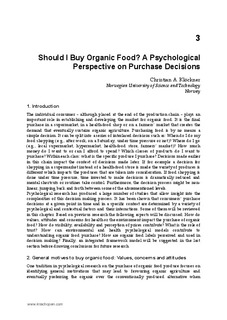| dc.contributor.author | Kløckner, Christian | |
| dc.date.accessioned | 2013-10-17T11:34:11Z | |
| dc.date.accessioned | 2016-07-08T07:55:10Z | |
| dc.date.available | 2013-10-17T11:34:11Z | |
| dc.date.available | 2016-07-08T07:55:10Z | |
| dc.date.issued | 2011 | |
| dc.identifier.citation | Reed, Matthew [Eds.] ORGANIC FOOD AND AGRICULTURE – NEW TRENDS AND DEVELOPMENTS IN THE SOCIAL SCIENCES p. 39-62, INTECH, 2011 | nb_NO |
| dc.identifier.isbn | 978-953-307-764-2 | |
| dc.identifier.uri | http://hdl.handle.net/11250/2396109 | |
| dc.description.abstract | The individual consumer – although placed at the end of the production chain – plays an important role in establishing and developing the market for organic food. It is the final purchase in a supermarket, in a health-food shop or on a farmers’ market that creates the demand that eventually sustains organic agriculture. Purchasing food is by no means a simple decision. It can be split into a series of interlaced decisions such as: When do I do my food shopping (e.g., after work, on a Saturday, under time pressure or not)? Where do I go (e.g., local supermarket, hypermarket, health-food store, farmers’ market)? How much money do I want to or can I afford to spend? Which classes of products do I want to purchase? Within each class: what is the specific produce I purchase? Decisions made earlier in this chain impact the context of decisions made later. If for example a decision for shopping in a supermarket instead of a health-food store is made the variety of produces is different which impacts the produces that are taken into consideration. If food shopping is done under time pressure, time invested to make decisions is dramatically reduced and mental shortcuts or routines take control. Furthermore, the decision process might be nonlinear, jumping back and forth between some of the aforementioned levels. Psychological research has produced a large number of studies that allow insight into the complexities of this decision making process. It has been shown that consumers’ purchase decisions at a given point in time and in a specific context are determined by a variety of psychological and contextual factors and their interactions. Some of them will be reviewed in this chapter. Based on previous research the following aspects will be discussed: How do values, attitudes and concerns for health or the environment impact the purchase of organic food? How do visibility, availability and perception of prices contribute? What is the role of trust? How can environmental and health psychological models contribute to understanding organic food purchase? How are organic food labels perceived and used in decision making? Finally, an integrated framework model will be suggested in the last section before drawing conclusions for future research | nb_NO |
| dc.language.iso | eng | nb_NO |
| dc.publisher | INTECH | nb_NO |
| dc.rights | Navngivelse 3.0 Norge | * |
| dc.rights.uri | http://creativecommons.org/licenses/by/3.0/no/ | * |
| dc.title | Should I Buy Organic Food? A Psychological Perspective on Purchase Decisions | nb_NO |
| dc.type | Chapter | nb_NO |
| dc.type | Peer reviewed | nb_NO |
| dc.date.updated | 2013-10-17T11:34:11Z | |
| dc.source.pagenumber | 39-55 | nb_NO |
| dc.identifier.doi | 10.5772/1526 | |
| dc.identifier.cristin | 886542 | |
| dc.description.localcode | Book chapters published in edited volumes are distributed under the Creative Commons Attribution 3.0 Unported License (CC BY 3.0). IN TECH upholds a very flexible copyright policy meaning that there is no copyright transfer to the publisher, and authors retain exclusive copyright to their work. | nb_NO |

